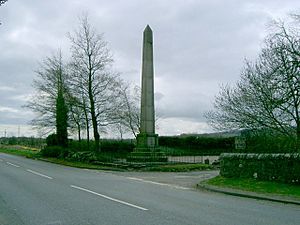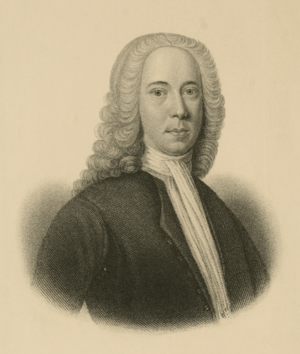Alexander Moncrieff (Secession minister) facts for kids
Quick facts for kids Alexander Moncrieff |
|
|---|---|

Culfargie
|
|
| Personal details | |
| Born | 17 July 1695 Scotland |
| Died | 7 October 1761 (aged 66) Culfargie |
| Buried | Culfargie |
| Denomination | (1) Church of Scotland (2) Secession Church (3) Anti-Burgher |
Alexander Moncrieff (1695–1761) was an important Scottish minister. He was a key figure in the creation of the Secession Church. This was a new church group that broke away from the main Church of Scotland. Moncrieff believed strongly in his faith and fought for what he thought was right.
Contents
Early Life and Education
Alexander Moncrieff was born on July 17, 1695, in Scotland. His family lived at a place called Culfargie. His father was Matthew Moncrieff, and his mother was Margaret Mitchell.
Alexander's grandfather, also named Alexander Moncrieff, was a well-known minister. This family history likely influenced young Alexander.
He went to Perth Grammar School to start his education. After that, he studied at the University of St Andrews. He earned his Master of Arts degree there in 1714.
Later, he traveled to Leiden University in the Netherlands. There, he studied theology, which is the study of religious faith.
Becoming a Minister
After his studies, Alexander Moncrieff became a licensed preacher in 1718. In September 1720, he was officially ordained as a minister. He served in his home parish of Abernethy.
During this time, the Church of Scotland faced many disagreements. One big issue was the "Marrow Controversy." This was about how people understood God's grace and salvation. Moncrieff joined others who wanted to keep the church's teachings pure.
Another major problem was "patronage." This meant that wealthy landowners, called patrons, could choose ministers for churches. This often happened without the local people's agreement. Moncrieff believed this was wrong. He felt that the people should have a say in who their minister was.
Forming the Secession Church
Alexander Moncrieff joined a group of ministers who spoke out against patronage. One of the main leaders was Ebenezer Erskine. Because they refused to follow the church's rules on this matter, the church leaders suspended them.
On November 16, 1733, the church declared that Moncrieff and his friends were no longer ministers of the Church of Scotland. But they did not give up.
On December 6, 1733, Moncrieff and his fellow ministers met at Gairney Bridge. There, they formed a new church group called the Associate Presbytery. This was the beginning of the Secession Church of Scotland.
A New Role and Challenges
The new Secession Church grew quickly. It soon needed a way to train its own ministers. In February 1742, Alexander Moncrieff was chosen to be their Professor of Divinity. This meant he would teach future ministers. He was very dedicated to this role.
Even after forming the new church, Moncrieff faced more challenges. From 1734 to 1740, he continued to preach in his old parish church. He lived in the minister's house and received his pay. However, he still disagreed with the main church's authority. He refused to attend their meetings.
Finally, on May 15, 1740, the Church of Scotland officially removed him from his position.
Later Years and Legacy
Moncrieff was also involved in another disagreement within the Secession Church. This was about something called the "Burgess Oath." He sided with those who were against this oath. This led to a split within the Secession Church in 1747. Moncrieff helped found the General Associate Synod.
He published some writings during his life. In 1750, he wrote a defense of the Secession Church. In 1756, he published "England's Alarm," which warned against wickedness. A small book of his thoughts, "A Drop of Honey from the Rock of Christ," was published after he died.
Alexander Moncrieff passed away on October 7, 1761. He was 66 years old. He was known for being a strong and brave person. His friends sometimes called him "the lion of the secession church." His work helped shape the United Presbyterian Church, which was formed later.
Family Life
Alexander Moncrieff was married twice.
His first wife was Mary Clerk. They married in 1722. They had two daughters, Christian and Margaret, who both died as babies. They also had a son named Matthew. Matthew later became a minister like his father.
His second wife was Jean Lyon. They married in 1728. Together, they had many children. Some of their children included:
- William, who also became a minister and a Professor of Divinity.
- George, who became a physician.
- Margaret, who married a minister.
- Agnes, who also married a minister.
- Ann and Jean, who both married.
Seven of their children sadly died when they were very young.




